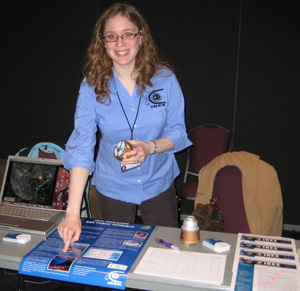Meet the IBEX Team: Christine Minerva

One of the first things I wrote for the IBEX mission went inside a fortune cookie. It read, "The IBEX mission is in your future," and listed the address of the new IBEX web site. If I had cracked open a cookie to find a similar fortune six years ago, I would have laughed. Working on NASA missions definitely did not appear to be in my future. Not only was I majoring in Fundamentals: Issues and Texts - an interdisciplinary humanities degree only offered at the University of Chicago - but I had also earned my lowest college grades during two quarters of Introduction to Astrophysics, taken to fulfill graduation requirements.
While I did not have the traditional science or engineering qualifications to work for NASA, I inadvertently built a resume suited for a museum education career. Although the University of Chicago did not offer an undergraduate education degree, I pursued an interest in teaching by joining a student-run organization where pairs of undergraduates led weekly "literature clubs" in Chicago Public Schools. In the summer, I worked as a teaching assistant in Des Plaines, Illinois, the northwest suburb where I grew up, and at the Center for Talent Development at Northwestern University. I also interned in the education and communications departments of the Frank Lloyd Wright Preservation Trust, which operates historic house museums in Chicago and Oak Park, Illinois.
I enjoyed museum work, and applied for a job as an assistant educator at the Adler Planetarium & Astronomy Museum, confident that the accidental astrophysics classes would help my application. The Adler staff offered me the position the day before my college graduation in 2002, and I was grateful that I attended a liberal arts college with a physical sciences requirement!
Now a senior educator at the Adler, I develop, deliver, and evaluate programs for school groups, scouts, and the general public. In addition, I have written scripts for planetarium shows, designed and written text for museum exhibits, and worked on education and public outreach programs for science missions like IBEX. The best part of my job is collaborating with talented coworkers to find innovative ways of presenting high-level science to the average museum visitor. That often includes uncovering fascinating stories behind objects in the museum's collection, or "trying out" activities or demonstrations with visitors during the development process. I also love planning exhibits and sky shows, which involves research, writing, design, and collaboration with astronomers, historians, and exhibit specialists.
Most recently, I have been creating activities about the science of the IBEX mission for museum educators to use with visitors in museums across the country. This week, I am developing a beanbag toss game that illustrates how the IBEX-lo and IBEX-hi detectors collect energetic neutral atoms to make a map of the Solar System's boundary. I am also collaborating with accessibility specialists to design tactile images of the IBEX spacecraft and the heliosphere for people who are blind or visually impaired. Next week, IBEX E/PO Lead Lindsay Bartolone (please link here to her profile) and I will travel to Boston to speak with teachers attending the National Science Teachers Association Conference about the products we have developed for the IBEX mission, and how they might modify them to use in their classrooms. The finished products will be available on the IBEX web site, and will be distributed to museums showing the yet-to-be-completed planetarium show about the IBEX mission.
Furthermore, I write articles - like this one - that feature an IBEX team member each month. I developed writing and editing skills working on the staffs of newspapers throughout high school and for a couple years in college. Since June 2005, I have profiled over 30 scientists, engineers, technicians, artists, and educators who work on IBEX mission. Because IBEX team members live all over the world, I usually interview them over the phone. Then, I spend 3-7 hours writing up the article for publication on the web site. The hardest part of the task is getting in contact with team members because they are so busy preparing for launch this July! Writing about the IBEX team for the web site has allowed me to talk to interesting people, and to learn what it takes to design, assemble, test, and launch a spacecraft that will collect data about our Universe.
Through my work on the IBEX mission and as a museum educator in general, I constantly get to learn about science, the history of astronomy, and educational theory by collaborating with Adler's astronomers, historians, and educators, and pursuing professional development opportunities. Learning new things on the job is fun as well, especially when it involves (safely) experimenting with liquid nitrogen, pop and Mentos, telescopes, and paper airplanes!
I enjoy learning when I am at home, too. Some of my favorite things to do include reading, watching PBS and movies, going to the theater, concerts, and sporting events. I love to explore restaurants and museums in Chicago and when I travel. Finally, I like to play the piano, cook, and bicycle commute on Chicago's lakefront path (but only for 6-8 relatively warm months of the year). In my free time, I sometimes do freelance writing for various alumni magazines.
Right now, "home" is a spacious apartment with lake views in a University of Chicago residence hall, where my husband, a PhD student in History, and I work as the Resident Heads for about 65 undergraduate students who live on our floor. We plan trips, host occasional dinners and weekly study breaks, assist in emergency situations, and advise students about all sorts of issues, including what classes to take. When students complain that they cannot understand why they must take calculus, or humanities, or physical science, I tell them the story of how a couple of required astrophysics classes helped a humanities major like me break into an unexpected career in astronomy education!